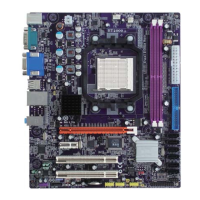37
Using BIOS
IDE DMA transfer access (Enabled)
This item allows you to enabled the transfer access of the IDE DMA then burst onto the PCI
bus and nonburstable transactions do not.
IDE Burst Mode (Enabled)
This option, when enabled will instruct the system to send every write transaction to the
write buffer. Burstable transactions then burst onto the PCI bus and nonburstable transac-
tions do not.
Press <Esc> to return to the Integrated Peripherals screen.
fSIS OnChip PCI Device
Scroll to this item and press <Enter> to view the following screen:
f
Phoenix-AwardBIOS CMOS Setup Utility
SIS OnChip PCI Device
Item Help
Menu Level
SIS USB Controller [Enabled]
USB 2.0 Supports [Enabled]
USB Legacy Support [Enabled]
USB Mouse Support [Disabled]
SIS AC97 AUDIO [Enabled]
SIS S/W Modem [Enabled]
SIS 10/100M ETHERNET [Enabled]
SiS Serial ATA Controller [Enabled]
SiS Serial ATA Mode [IDE]
f
: Move Enter: Select +/-/PU/PD:Value F10:Save ESC:Exit F1: General Help
mnlk
F5:Previous Values F6:Fail-Safe Defaults F7:Optimized Defaults
SIS USB Controller (Enabled)
This item enables the USB controller. Leave this at the default “Enabled” if you want to
connect USB devices to your computer.
SIS AC97 AUDIO (Enabled)
This option allows you to control the onboard AC97 audio. Disable this item if you are
going to install a PCI audio add-on card.
SIS S/W Modem (Enabled)
This option allows you to control the onboard S/W modem. Disable this item if you are
going to install an external modem.
USB Mouse Support (Disabled)
Enable this item if you plan to use a mouse connected through the USB port in a legacy
operating system (such as DOS) that does not support Plug and Play.
USB 2.0 Support (Enabled)
Enable this item if want to use the USB 2.0.
USB Legacy Support (Enabled)
This item allows the BIOS to interact with a USB keyboard or mouse to work with MS-DOS
based utilities and non-Windows modes.

